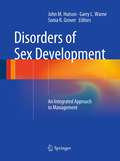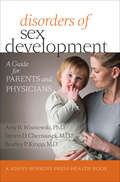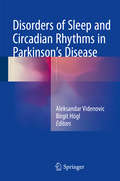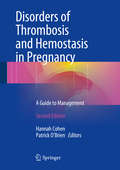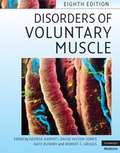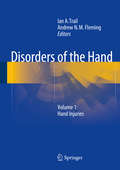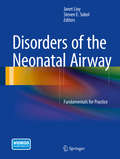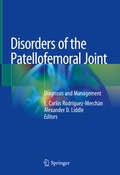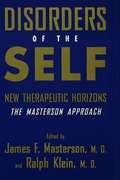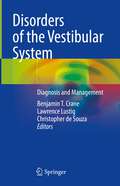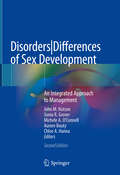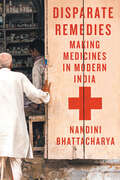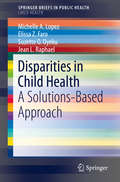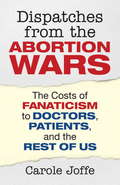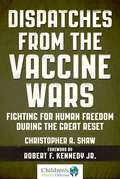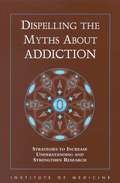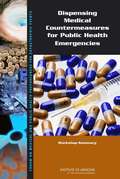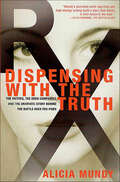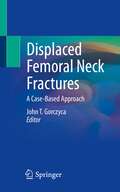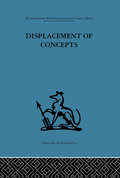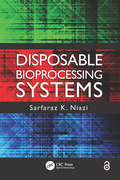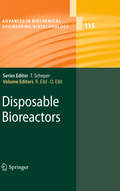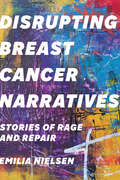- Table View
- List View
Disorders of Sex Development
by John M. Hutson Garry L. Warne Sonia R. GroverThe rapid advances in medicine over the last 50 years have totally changed the outlook for children with disorders of sex development (DSD), but there is still much to learn. This book crystallizes the combined experience of a leading dedicated unit over 25 years in delivering expert medical and surgical care to children with DSD in a holistic environment. It documents the most recent advances in the molecular biology and embryology of sex development, and describes each disorder in detail. The clinical presentation and approach to diagnosis are described both for babies and for children presenting later in childhood or at adolescence. The chapters on management highlight all the latest knowledge and include the shared wisdom of the authors on current controversies, such as the timing of surgical treatment. Finally, the authors describe their short-, medium-, and long-term outcomes, which demonstrate the strengths of holistic team management.
Disorders of Sex Development: A Guide for Parents and Physicians (A Johns Hopkins Press Health Book)
by Amy B. Wisniewski Steven D. Chernausek Bradley P. KroppCompassionately written by an experienced team of professionals, this book offers parents and families essential information about the causes, diagnosis, and treatment of disorders of sex development, or DSD.DSD refers to medical conditions, usually discovered at birth, in which there is disagreement between a person's genetic sex (i.e., chromosomes) and the appearance of the person's external or internal reproductive structures. After their child is diagnosed with DSD, parents need answers to a host of questions, including• What is DSD, why does it occur, how is it identified, and how is it treated?• Did we do something to cause our child's DSD?• Is my baby a boy or a girl?• Will my child grow up to be normal and healthy?• Does my child need surgery?This concise book answers parents' questions in a reassuring and forthright way, giving affected individuals, their families, and their health care providers a current and evidence-based picture of DSD. It offers clear explanations of how newborns with DSD are evaluated, diagnosed, and treated; describes the different kinds of DSD; and pays close attention to both psychosocial and medical aspects of DSD. This guide also includes information about the importance of support groups and education for affected individuals and their families.In their daily work, the authors treat, support, and educate people with DSD and their families. This resource gives parents and families access to the authors' expertise so they can reach a meaningful understanding of their child's DSD and make informed decisions about their child's health.
Disorders of Sleep and Circadian Rhythms in Parkinson's Disease
by Aleksandar Videnovic Birgit HöglThis book is the first to take into account the rapidly growing body of knowledge on the relation between sleep and PD. Gathering contributions from internationally recognized experts, it provides a unique source of in-depth information on sleep and circadian dysregulation in Parkinson's disease. The book is divided into two parts: the first comprises chapters on normal sleep-wake homeostasis, followed by changes that occur in PD and discussions of available tools for the assessment of sleep-wake cycles in PD. In the second part, sleep and circadian disorders associated with PD are described in individual chapters, including sections on epidemiology, etiology, pathogenesis, differential diagnosis, and treatment. Controversies in the field, such as the relations between cognition and sleep, fatigue and sleepiness, and the potential impact of surgical therapies on sleep-wake cycles are discussed separately. The book closes with a chapter on future directions and unmet needs in the field of sleep, circadian biology and PD. This comprehensive text offers a readily accessible resource for clinicians and researchers alike, addressing the needs of neurologists, sleep and movement disorders specialists, and all trainees and allied health professionals involved in the care of patients affected by Parkinson's disease.
Disorders of Thrombosis and Hemostasis in Pregnancy
by Hannah Cohen Patrick O'BrienThis book will offer a comprehensive guide to disorders of thrombosis and haemostasis in pregnancy. It will highlight the latest developments and controversial issues. The multidisciplinary approach will provide authoritative clinical advice on state-of-the-art management. The disorders to be covered are highly pertinent to successful pregnancy outcome, and many may be associated with significant maternal and/or fetal morbidity, and even mortality. This book will be relevant for individuals in all disciplines involved in the care of women with disorders of thrombosis and haemostasis in pregnancy.
Disorders of Voluntary Muscle
by George Karpati David Hilton-Jones Kate Bushby Robert C. GriggsThis major new edition fulfils the need for a single-volume, up-to-date information resource on the etiology, pathogenesis, diagnosis and treatment of diseases of skeletal muscles, including the muscular dystrophies, mitochondrial myopathies, metabolic myopathies, ion channel disorders, and dysimmune myopathies. As background to the clinical coverage, relevant information on advances in molecular and developmental biology, immunopathology, mitochondrial biology, ion-channel dynamics, cell membrane and signal transduction science, and imaging technology is summarized. Combining essential new knowledge with the fundamentals of history-taking and clinical examination, this extensively illustrated book will continue to be the mainstay for practising physicians and biomedical scientists concerned with muscle disease. Regular updates on the clinical and basic science aspects of muscle disease - written mainly by rising stars of myology - will be published on an accompanying website.
Disorders of the Hand
by Ian A. Trail Andrew N.M. FlemingDisorders of the Hand describes the techniques for diagnosis applicable to the various disorders of the hand and how evidence based findings influence clinical practice. Treatment options including surgery are discussed in detail and clinical pearls are given in every chapter. Swelling, tumours, congenital hand defects and surgical techniques are comprehensively covered in this third of four volumes, while hand injuries, nerve compression, hand reconstruction, inflammation, arthritis and contractures are included in the book's three sister volumes.
Disorders of the Neonatal Airway
by Janet Lioy Steven E. SobolDisorders of the Neonatal Airway serves as a comprehensive, multidisciplinary resource for all practitioners who care for neonates with airway disorders. With the evolution of advances in neonatology and neonatal airway care over the past three decades, the survival rate and life expectancy of premature newborns have dramatically increased to well over 50% in 24-25 week gestation infants. Unfortunately, survival with long-term intubation has brought a corresponding increase in acquired airway disorders needing collaborative high level neonatal and otolaryngological care. Additionally, with the advent of fetal therapy, congenital airway disorders now make up a substantial number of neonates with complex airway disorders. Because of this fact, there has been increased focus on the multidisciplinary evaluation and management of neonatal airway disorders. The book is organized into three sections: the first focuses on Malformations and Deformations, the second focuses on Assessment, Evaluation, and Treatment, and the third discusses Education, Simulation, and Quality. As one of the only comprehensive resources on the topic, Disorders of the Neonatal Airway focuses on a multidisciplinary approach to the neonatal airway. This unique approach makes this reference a must read for practitioners from many disciplines. The book is organized into three sections: the first focuses on Malformations and Deformations, the second focuses on Assessment, Evaluation, and Treatment, and the third discusses Education, Simulation, and Quality. As one of the only comprehensive resources on the topic, Disorders of the Neonatal Airway focuses on a multidisciplinary approach to the neonatal airway. This unique approach makes this reference a must read for practitioners from many disciplines. The book is organized into three sections: the first focuses on Malformations and Deformations, the second focuses on Assessment, Evaluation, and Treatment, and the third discusses Education, Simulation, and Quality. As one of the only comprehensive resources on the topic, Disorders of the Neonatal Airway focuses on a multidisciplinary approach to the neonatal airway. This unique approach makes this reference a must read for practitioners from many disciplines.
Disorders of the Patellofemoral Joint: Diagnosis and Management
by E. Carlos Rodríguez-Merchán Alexander D. LiddleThis state-of-the-art book provides a comprehensive overview of the most common patellofemoral joint problems. Utilizing the latest evidence, it guides readers through prevention, diagnosis and treatment for both adult and paediatric patients. After discussing clinical examination and diagnosis, it explores topics such as acute and recurrent dislocation of the patella, cartilage defects of the joint, patellofemoral instability and patellofemoral osteoarthritis. The book also features a chapter on conservative strategies, including physical medicine and rehabilitation. Research is moving quickly in this field, and as such there is a growing need for consensus documents: written by leading experts, this comprehensive book is a valuable resource for orthopaedic surgeons, knee specialists and sports medicine ones, and is also of great interest to physiatrists, physical therapists and all healthcare workers involved in the care of these patients.
Disorders of the Self: New Therapeutic Horizons: The Masterson Approach
by James F. Masterson Ralph KleinFirst published in 1996. Routledge is an imprint of Taylor & Francis, an informa company.
Disorders of the Vestibular System: Diagnosis and Management
by Benjamin T. Crane Lawrence Lustig Christopher De SouzaThis book gives the reader an appropriate background for diagnosing and treating patients with vestibular disorders. Most causes of vertigo can be effectively treated, and there have been major advancements in both vertigo diagnosis and treatment in recent years. Unfortunately for many practitioners, modern training in the management of vertigo was not included as part of their residency. The major barrier to effective treatment in most patients seems to be lack of awareness of the correct diagnoses and treatment options on the part of providers. This book directly addresses that knowledge gap.The text is divided into 16 chapters. The initial chapters are an overview of normal vestibular anatomy, function, and testing. The next section of the book builds on these chapters to discuss the treatment of specific disorders like Ménière’s disease, vestibular neuritis, benign paroxysmal positional vertigo, and third mobile window conditions. The connection between vestibular disorders and psychiatric conditions such as anxiety and depression is discussed. Recent advancements in the treatment of vestibular disorders are covered with chapters on vestibular physical therapy and vestibular implantation. The book closes with a discussion of aging and the vestibular system.Disorders of the Vestibular System is an excellent guide to this rapidly evolving field and will be of great use to physicians in otolaryngology, neurology, and general practice who are likely to encounter patients with dizziness and vertigo.
Disorders|Differences of Sex Development: An Integrated Approach to Management
by John M. Hutson Sonia R. Grover Michele A. O’Connell Aurore Bouty Chloe A. HannaThe new, fully updated edition of this successful book, brings together the combined experience of a leading dedicated unit over 25 years in delivering expert medical and surgical care to children with DSD (Disorders|Differences of Sex Development) in a holistic environment. It documents the most recent advances in the molecular biology and embryology of sex development, and describes each variation in detail. The main focus of the book is on patients with variations with their anatomy and hormone function. New chapters describe the developments in the field in terms of definitions and incidence, the mental health of DSD patients and discuss the perspectives of patients families and support groups. The clinical presentation and approach to diagnosis are described both for babies and for children presenting later in childhood or at adolescence. The chapters on management highlight all the latest knowledge and include the shared wisdom of the authors on current controversies, such as the timing of surgical treatment. Finally, the authors describe their short-, medium-, and long-term outcomes, which demonstrate the strengths of holistic team management.
Disorganized Attachment and Caregiving
by Carol George Judith SolomonIn this volume, leading authorities provide a state-of-the-art examination of disorganized attachment what it is, how it can be identified, and its links to behavioral problems and psychological difficulties in childhood and beyond. The editors offer a fresh perspective on disorganized attachment, not as a characteristic of the infant or child but as the product of a dysregulated and disorganized parent child relationship. They present cutting-edge research and exemplary treatment approaches. With attention to the subjective experiences of both mothers and children, the book shows how focusing on the care giving system can advance research and clinical practice.
Disparate Remedies: Making Medicines in Modern India (Intoxicating Histories #7)
by Nandini BhattacharyaAt present India is a leading producer, distributor, and consumer of generic medicines globally. Disparate Remedies traces the genealogy of this development and examines the public cultures of medicine in the country between 1870 and 1960.The book begins by discussing the expansion of medical consumerism in late nineteenth-century India when British-owned firms extended their sales into remote towns. As a result, laboratory-produced drugs competed with traditional remedies through side-by-side production of Western and Indian drugs by pharmaceutical companies. The emergent middle classes, the creation of a public sphere, and nationalist politics transformed the medical culture of modern India and generated conflict between Western and Indigenous medical systems and their practitioners. Nandini Bhattacharya demonstrates that these disparate therapies were sustained through the tropes of purity or adulteration, potency or lack of it, and epistemic heritage, even when their material configuration often differed little.Uniquely engaging with the cultures of both consumption and production in the country, Disparate Remedies follows the evolution of medicine in colonial India as it confronted Indian modernity and changing public attitudes surrounding health and drugs.
Disparities in Child Health: A Solutions-based Approach (SpringerBriefs in Public Health)
by Michelle A. Lopez Elissa Z. Faro Suzette O. Oyeku Jean L. RaphaelThis forward-looking resource shines needed light on—and offers realistic solutions for eliminating—health disparities affecting one of the most vulnerable populations: children. Its multilevel framework identifies sources of pediatric health inequities in developmental, societal, familial, financial, and service delivery contexts and sets out innovations for breaking down and addressing longstanding concerns. Plentiful opportunities are described for reducing gaps and promoting equity at various service platforms, from locally-based improvements to systemwide tech upgrades, that can be used as models for revamping larger health policy. And the authors’ long-term perspective emphasizes screening, wellness care, early intervention, and prevention strategies to support young patients in the transitions between childhood, adolescence, and young adulthood. Included in this compact idea book:Disparities in child health: a reviewQuality of care in pediatrics and health disparities: the increasing role of quality improvement scienceCommunity health worker interventionsTechnology-based interventions to address pediatric health disparitiesPlace-based strategies in promoting health equityFuture directions for a solutions-based approachWith its clear delineation of issues and priorities, and its workable recommendations for addressing them, Disparities in Child Health is a ready source of ideas and advocacy for practitioners and researchers in pediatrics, maternal and child health, and general practice/family medicine.
Dispatches from the Abortion Wars
by Carole JoffeSurprising firsthand accounts from the front lines of abortion provision reveal the persistent cultural, political, and economic hurdles to access More than thirty-five years after women won the right to legal abortion, most people do not realize how inaccessible it has become. In these pages, reproductive-health researcher Carole Joffe shows how a pervasive stigma--cultivated by the religious right--operates to maintain barriers to access by shaming women and marginalizing abortion providers. Through compelling testimony from doctors, health-care workers, and patients, Joffe reports the lived experiences behind the polemics, while also offering hope for a more compassionate standard of women's health care. From the Trade Paperback edition.
Dispatches from the Vaccine Wars: Fighting for Human Freedom During the Great Reset (Children’s Health Defense)
by Christopher A. ShawEnter the trenches of the bloodiest battles you've never heard of: the Vaccine Wars. Professor Christopher A Shaw discovered, after a deep-dive literature search on aluminum impacts on humans and animals, that aluminum hydroxide, an adjuvant in the anthrax vaccine, had a significantly negative impact on motor functions and reflexes of patients in the literature. After that finding, he did what scientists are supposed to do and kept following the leads. However, organizations like WHO dismissed him immediately. Those powerful organizations either knew what he knew, that aluminum vaccine adjuvants were harmful, or they simply didn&’t care. In either case, two possible reasons for the lack of response became clear to Shaw and his colleagues: dogma and money. The first had served to convince most of the world&’s medical professionals that Shaw had to be wrong because, after all, &“the science was settled.&” And, behind much of this was the naked fact of how much money vaccines brought in to cover the pharmaceutical industry&’s profit margin. The combination of those two have the finger prints of various Big Pharma companies smudged all over the question of vaccine safety, which included the demonization of both scientists and lay scholars who raised even the tamest questions about safety and the push for vaccine mandates around the world. After these events, Shaw decided to dig deeper.Dispatches from the Vaccine Wars is a comprehensive look at the origin of vaccination and the oversight of vaccines by various regulatory bodies in the United States and in Canada. The book provides not only the official view on vaccines safety and efficacy, but also provides a critical analysis on which such views are based. Aluminum and other compounds that may contribute to autism spectrum disorder are discussed at length. Professor Shaw also analyzes the corporate influences driving vaccine uptake worldwide and provides an in depth look at the push for mandatory vaccination. Dispatches from the Vaccine Wars evaluates the extent to which vaccinology has become a cult religion driving attempts to suppress divergent scientific opinions. Finally, the book delves into the COVID-19 pandemic and what it means for the future of us all.
Dispelling the Myths about Addiction: Strategies to Increase Understanding and Strengthen Research
by Committee to Identify Strategies to Raise the Profile of Substance Abuse Alcoholism ResearchEvery year about half a million men, women, and children in the United States die from the effects of using nicotine, alcohol, and illegal drugs: one of every four American deaths. Yet research to solve this terrible problem is often perceived as less important than other types of biomedical investigation.Focusing on four major classes of drugs with the greatest social and economic impact--nicotine, alcohol, opioids, and stimulants--Dispelling the Myths About Addiction examines what is known about addiction and what is needed to develop a talented cadre of investigators and to educate the public about addiction research. The committee explores these areas: Economic costs of addiction. What has been learned about addiction from research into basic neurobiology and the brain, psychosocial and behavioral factors, and epidemiology. Education and training of researchers and the research infrastructure. Public perceptions and their impact on public policy in this field. This volume outlines the challenges and opportunities in addiction research today and makes recommendations to educators, treatment professionals, public and private institutions, and others for how to build support for addiction research and treatment.
Dispensing Medical Countermeasures for Public Health Emergencies: Workshop Summary
by Institute of Medicine of the National AcademiesOn March 3-4, 2008, the Institute of Medicine (IOM) Forum on Medical and Public Health Preparedness for Catastrophic Events hosted a workshop titled “Medical Countermeasures Dispensing.” The overall objective was to discuss a range of solutions to rapidly provide medical countermeasures to protect large numbers of people prior to or during a public health emergency, such as a bioterrorist attack or infectious disease outbreak. The United States is currently unprepared to confront the range of threats it is facing, such as an intentional anthrax release, severe acute respiratory syndrome (SARS), or pandemic influenza, and it must plan aggressively to counteract the threat of these and other future public health emergencies. Countermeasure dispensing must harness all types of imaginative partnerships between public and private institutions, working together in ways tailored to meet individual community needs. This workshop summary highlights the presentations and subsequent discussion that occurred at the workshop.
Dispensing with the Truth: The Victims, the Drug Companies, and the Dramatic Story Behind the Battle over Fen-Phen
by Alicia MundySemi-finalist for the Robert F. Kennedy Memorial Book AwardIn 1996, a terrible epidemic began killing young American women. Some died quickly, literally dropping in their steps. Others took more time, from a few months to a few years. Those who weren't killed suffered damage to their lungs and hearts, much of it permanent and reparable only with major surgery. Doctors suspected what the killer was. So did the Food and Drug Administration. The culprits were the two most popular diet drugs in the United States, Pondimin, one-half of the popular drug combination Fen-Phen, and Redux, a stronger version of Pondimin. They were also two of the most profitable drugs on the market, and both were produced and sold by a powerful pharmaceutical company, Wyeth-Ayerst, a division of American Home Products. Dispensing the Truth is the gripping storry of what the drug really knew about its drugs, the ways it kept this information from the public, doctors, and FDA, and the massive legal battles that ensued as victims and their attorneys searched for the truth behind the debacle.It tells the story of a healthy young woman, Mary Linnen, who took the drugs for only twenty-three days to lose weight before her wedding, and then died in the arms of her fiance a few months later. Hers was the first wrongful-death suit filed amd would become the most important single suit the company would ever face.Alicia Mundy provides a shocking and thoroughly riveting narrative. It is a stark look at the consequences of greed and a cautionary tale for the future.
Displaced Femoral Neck Fractures: A Case-Based Approach
by John T. GorczycaUtilizing detailed case presentations from experts in the field, this book presents common clinical scenarios involving patients who have sustained displaced femoral neck fractures, discussing the injury mechanism, early treatment, potential treatment options, risks and complications involved. The style of presentation, the ease of readability, the use of appropriate and relevant cases to highlight the learning points, and the discussion of the decision-making process are all unique features of the book's approach. Using this tailored process, the each topic is reviewed and the rationale for what appears to be the optimal treatment - hemiarthroplasty or total hip replacement, for example - is provided to the reader, emphasizing that the ultimate decision requires the combination of science and judgment, both of which are continually evolving. Additional chapters present ongoing controversies in the management of these challenging fractures, as well as complications such as aseptic necrosis, symptomatic hardware and nonunions.Portable and concise, orthopedic and trauma surgeons, residents and fellows alike will find Displaced Femoral Neck Fractures a practical and user-friendly resource.
Displacement of Concepts
by Donald A SchonTavistock Press was established as a co-operative venture between the Tavistock Institute and Routledge & Kegan Paul (RKP) in the 1950s to produce a series of major contributions across the social sciences. This volume is part of a 2001 reissue of a selection of those important works which have since gone out of print, or are difficult to locate. Published by Routledge, 112 volumes in total are being brought together under the name The International Behavioural and Social Sciences Library: Classics from the Tavistock Press. Reproduced here in facsimile, this volume was originally published in 1963 and is available individually. The collection is also available in a number of themed mini-sets of between 5 and 13 volumes, or as a complete collection.
Disposable Bioprocessing Systems
by Sarfaraz K. NiaziWritten by a researcher with experience designing, establishing, and validating biological manufacturing facilities worldwide, this is the first comprehensive introduction to disposable systems for biological drug manufacturing. It reviews the current state of the industry; tackles questions about safety, costs, regulations, and waste disposal; and guides readers to choose disposable components that meet their needs. This practical manual covers disposable containers, mixing systems, bioreactors, connectors and transfers, controls and sensors, downstream processing systems, filling and finishing systems, and filters. The author also shares his predictions for the future, calling disposable bioprocessing technology a "game changer."
Disposition Of The Air Force Health Study
by Institute of Medicine of the National AcademiesThe Air Force Health Study (AFHS)-also known as the Ranch Hand Study-was initiated by the U. S. Air Force in 1979 to assess the possible health effects of military personnel's exposure to Agent Orange and other chemical defoliants sprayed during the Vietnam War, some of which contained dioxin. Over its 25 years, the AFHS has gathered exceptionally detailed physical, mental, and demographic data on nearly 2,800 subjects, including over 86,000 stored serum, semen, and other biospecimens. In addition, reproductive data were collected on 8,100 live births of offspring and mortality data on over 20,000 Vietnam War-era veterans. Disposition of the Air Force Health Study summarizes the contents of the AFHS data assets and offers recommendations on what to do with this trove of information. Its central conclusion is that medical records, other study data, and biospecimens should be transferred to a new custodial organization that would make the materials available for outside investigators for future research. Several organizations are identified as viable candidates to manage these assets.
Disrupting Breast Cancer Narratives: Stories of Rage and Repair
by Emilia NielsenEngaging with discussions surrounding the culture of disease, Disrupting Breast Cancer Narratives explores politically insistent narratives of illness. Resisting the optimism of pink ribbon culture, these stories use anger as a starting place to reframe cancer as a collective rather than an individual problem. Disrupting Breast Cancer Narratives discusses the ways emotion, gender, and sexuality, in relation to breast cancer diagnosis and treatment, all become complicated, relational, and questioning. Providing theoretically informed close-readings of breast cancer narratives, this study explores how disruption functions both personally and politically. Highlighting a number of contributors in the field of health and gender studies including Barbara Ehrenreich, Kathlyn Conway, Audre Lorde, and Teva Harrison, this work takes into account documentary film, television, and social media as popular mediums used to explore stories of disease.
